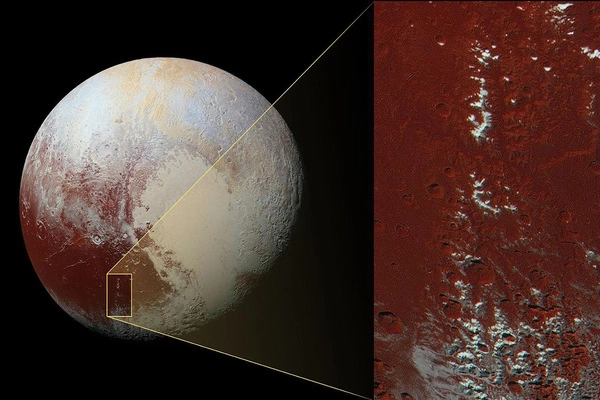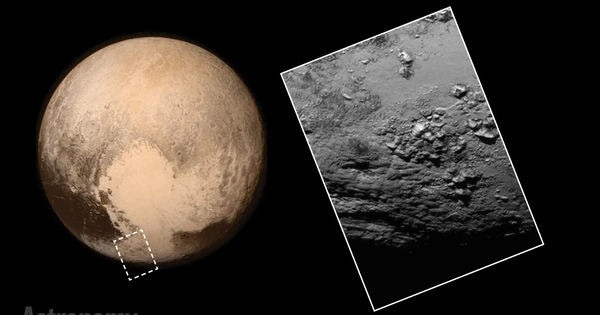According to a new study, Pluto’s winds are controlled by a “beating heart” of frozen nitrogen, which may give rise to features on its surface. Pluto’s famous heart-shaped structure, known as Tombaugh Regio, rose to prominence after NASA’s New Horizons mission captured footage of the dwarf planet in 2015, revealing that it isn’t the barren world scientists thought it was.
New research indicates that Pluto’s renowned nitrogen heart governs its atmospheric circulation. The discovery of Pluto’s atmosphere provides scientists with another location to compare to our own planet. Such discoveries can identify similarities and differences between Earth and a dwarf planet billions of miles away.
The majority of Pluto’s thin atmosphere is made up of nitrogen gas, an element found in air on Earth, as well as trace amounts of carbon monoxide and the greenhouse gas methane. Pluto’s surface is also covered in frozen nitrogen in the shape of a heart. A thin layer of this nitrogen ice warms and turns into vapor during the day. At night, the vapor condenses and turns back into ice. Each sequence functions similarly to a heartbeat, pumping nitrogen winds around the dwarf planet.
According to new research published in the American Geophysical Union’s Journal of Geophysical Research: Planets, this cycle causes Pluto’s atmosphere to circulate in the opposite direction of its spin, a phenomenon known as retro-rotation. As air whips close to the surface, it transports heat, grains of ice and haze particles to create dark wind streaks and plains across the north and northwestern regions.
Sputnik Planitia could be as important to Pluto’s climate as the ocean is to Earth’s. You won’t have the same circulation if you remove Sputnik Planitia — if you remove Pluto’s heart. This highlights the fact that Pluto’s atmosphere and winds, even if the density of the atmosphere is very low, can impact the surface
Tanguy Bertrand
“This highlights the fact that Pluto’s atmosphere and winds, even if the density of the atmosphere is very low, can impact the surface,” said Tanguy Bertrand, the study’s lead author, and an astrophysicist and planetary scientist at NASA’s Ames Research Center in California.
Tombaugh Regio contains the majority of Pluto’s nitrogen ice. Its left “lobe” is a 1,000-kilometer (620-mile) ice sheet located in Sputnik Planitia, a 3-kilometer (1.9-mile) deep basin that holds the majority of the dwarf planet’s nitrogen ice due to its low elevation. The right “lobe” of the heart is made up of highlands and nitrogen-rich glaciers that extend into the basin.
“Before New Horizons, everyone thought Pluto was going to be a netball – completely flat, almost no diversity,” Bertrand said. “But it’s completely different. It has a lot of different landscapes and we are trying to understand what’s going on there.”

Western winds
Bertrand and his colleagues set out to determine how circulating air — which is 100,000 times thinner than that of Earth’s — might shape features on the surface. The team pulled data from New Horizons’ 2015 flyby to depict Pluto’s topography and its blankets of nitrogen ice. They then simulated the nitrogen cycle with a weather forecast model and assessed how winds blew across the surface.
During most of the year, Pluto’s winds above 4 kilometers (2.5 miles) blow to the west, the opposite direction of the dwarf planet’s eastern spin, in a retro-rotation. According to the new study, as nitrogen in Tombaugh Regio vaporizes in the north and freezes in the south, its movement causes westward winds. Except for Neptune’s moon Triton, there is no other place in the solar system with such an atmosphere.
The researchers also discovered a strong current of fast-moving, near-surface air along the basin’s western boundary. The airflow is similar to wind patterns on Earth, such as the Kuroshio along Asia’s eastern edge. According to the new findings, atmospheric nitrogen condensing into ice drives this wind pattern. The high cliffs of Sputnik Planitia trap cold air inside the basin, where it circulates and strengthens as it passes through the western region.
Candice Hansen-Koharcheck, a planetary scientist with the Planetary Science Institute in Tucson, Arizona, who was not involved in the new study, was intrigued by the existence of the intense western boundary current.
“It’s very much the kind of thing that’s due to the topography or specifics of the setting,” she said. “I’m impressed that Pluto’s models have advanced to the point that you can talk about regional weather.”
On the broader scale, Hansen-Koharcheck thought the new study was intriguing. “This whole concept of Pluto’s beating heart is a wonderful way of thinking about it,” she added.
These wind patterns from Pluto’s nitrogen heart could explain why the planet has dark plains and wind streaks to the west of Sputnik Planitia. Winds could transport heat, which would warm the surface, or haze particles, which would erode and darken the ice. If the dwarf planet’s winds blew in a different direction, its landscapes could look drastically different.
“Sputnik Planitia could be as important to Pluto’s climate as the ocean is to Earth’s,” Bertrand said. “You won’t have the same circulation if you remove Sputnik Planitia — if you remove Pluto’s heart,” he added.
The new findings enable researchers to explore the atmosphere of an exotic world and compare what they discover to what they know about Earth. The new research also sheds light on an object 6 billion kilometers (3.7 billion miles) from the sun that has captivated audiences all over the world. “Pluto has something for everyone,” Bertrand said.
















